Chris Lundy
To some extent, narrower skis are making a comeback in the world of ski touring. Part of the greater theme of achieving more with less, many backcountry skiers are finding they can do more skiing with less effort by taking advantage of today’s crop of minimalistic yet high performance ski touring equipment. With this thought in mind, I’ve spent the past three weeks on the Atomic Backland 95 ski and Backland Tour binding.
The Skis
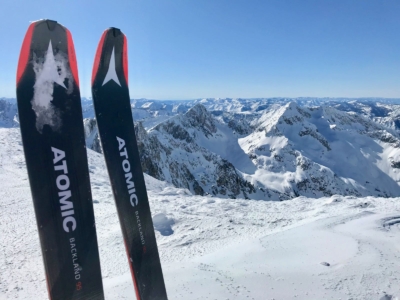
Now I’m not talking about a return to the skinny skis of yesteryear, or narrow skimo racing planks, but a more middle-of-the-road 95mm underfoot. Some might chuckle at calling that width “narrow,” the Atomic Backland 95 was definitely a downsize for me. But narrower skis are lighter and tend to be more versatile in variable snow – and are more easily driven by a modern, lightweight, touring-oriented boot. I’ve been skiing them with an Atomic Backland Carbon boot.
The Backland 95 is a lightweight ski touring ski with a fairly traditional shape. It has camber underfoot, a bit of tip rocker, step-down sidewalls, and a 19m turn radius. An interesting feature is the horizontally rockered, “spooned” tip which is designed to reduce hookiness and ease turn initiation. A lightweight Poplar and Caruba core is combined with a carbon backbone to keep the ski both light and stout. The tip notch fits Atomic skins (which are excellent by the way). Each ski with Backland Tour binding weighs 3 pounds 13 ounces (1727 grams). In other words, light!
So far I have about 15 days on these skis in all types of conditions – ranging from breakable crust and boilerplate to some of the best powder I’ve yet to ski in Idaho. Spoiler alert: I’m impressed.
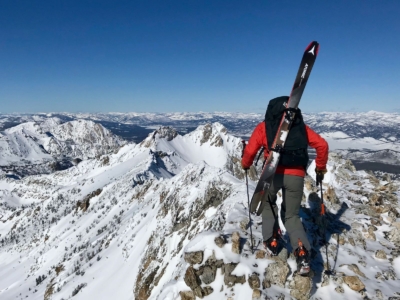 My first turns on these were in transitional, funky, warm snow on a solar aspect. I was expecting the worst, but I quickly became comfortable on the skis as they snapped from one short radius turn to the next, inspiring me to open them up into larger arcs towards the end of the run. The way they railed then popped you into the next turn definitely felt inspired by Atomic’s race heritage. The next several days of testing in the Sawtooth high alpine served up boilerplate, breakable wind board, and bulletproof frozen crust. I found them to be both predictable and reliable, handling these conditions remarkably well – especially for such a lightweight ski. The next outing was a 17 mile, 6000 vertical foot mission deep into the Sawtooths where I appreciated the lightweight and touring efficiency of a narrower ski.
My first turns on these were in transitional, funky, warm snow on a solar aspect. I was expecting the worst, but I quickly became comfortable on the skis as they snapped from one short radius turn to the next, inspiring me to open them up into larger arcs towards the end of the run. The way they railed then popped you into the next turn definitely felt inspired by Atomic’s race heritage. The next several days of testing in the Sawtooth high alpine served up boilerplate, breakable wind board, and bulletproof frozen crust. I found them to be both predictable and reliable, handling these conditions remarkably well – especially for such a lightweight ski. The next outing was a 17 mile, 6000 vertical foot mission deep into the Sawtooths where I appreciated the lightweight and touring efficiency of a narrower ski.
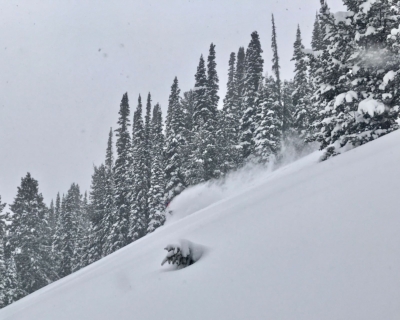 After a dry first half of February, powder (and lots of it) returned to central Idaho, and I had the opportunity to test these in snow where I’d usually reach for a wider ski. Now I’m not saying there weren’t times where I longed for more float or a more playful feel, but I still had a blast skiing them in deep, soft conditions. And their light weight made it easier to get more powder skiing in for the same amount of effort. With just a hair more tip rocker and a bit less camber, these skis would likely do even better in powder – but possibly losing some of their versatility in variable conditions.
After a dry first half of February, powder (and lots of it) returned to central Idaho, and I had the opportunity to test these in snow where I’d usually reach for a wider ski. Now I’m not saying there weren’t times where I longed for more float or a more playful feel, but I still had a blast skiing them in deep, soft conditions. And their light weight made it easier to get more powder skiing in for the same amount of effort. With just a hair more tip rocker and a bit less camber, these skis would likely do even better in powder – but possibly losing some of their versatility in variable conditions.
Durability is always a concern with lighter skis, and 15 days is by no means an extensive test. But so far they are holding up exceptionally well.
The Atomic Backland 95 ski could be a quiver of one for many (or most) folks, or a daily driver for all but the deepest powder days.
The Binding
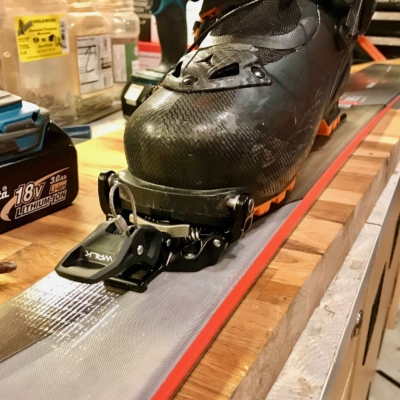 While ski performance can be difficult to describe and very personal, touring bindings are much easier to evaluate. Do they keep you attached to the ski? Are they user friendly? Are they durable? How much do they weigh? And the answers for the Atomic Backland Tour bindings are simple: yes, yes, yes, and not much!
While ski performance can be difficult to describe and very personal, touring bindings are much easier to evaluate. Do they keep you attached to the ski? Are they user friendly? Are they durable? How much do they weigh? And the answers for the Atomic Backland Tour bindings are simple: yes, yes, yes, and not much!
I have around 50 days total on the Backland binding and the identical Salomon MTN binding. They are far and away my favorite touring binding to date. They’re a marriage of a traditional tech and skimo race binding, yielding a design that works remarkably well for daily touring, but weighs significantly less than most tech bindings.
The unique feature of the Backland bindings are the use of a skimo race-style “U” spring for heel retention, but unlike race bindings, the Backland comes with three springs of varying stiffnesses. At 190 pounds plus 20-30 more pounds of gear, I’ve been using the middle stiffness spring and haven’t pre-released yet. While the release mechanism isn’t as sophisticated as some of the newer tech bindings (Fritschi Vipec, Dynafit Radical 2.0, Marker Kingpin), they are much, much lighter – just 10 ounces (288 grams) per binding.
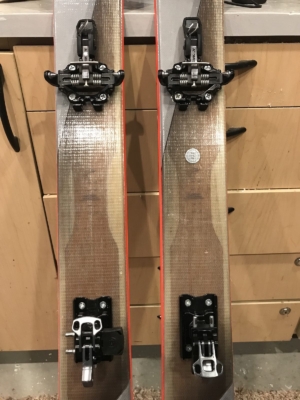
They are extremely easy to operate. The heel can be twisted 90 degrees for a flat-on-ski tour mode. At the top of the run, a quick poke with a pole grip returns it to ski mode. The two-level heel risers are also easily manipulated with a ski pole. The toe jaws clamp shut with more force than your usual tech binding, and I’ve found that I can tour in these with the toes unlocked in soft, friendly skinning conditions – one less step and an added degree of safety in avy terrain. While I’ve been using a brake-less version, brakes are available and have received great reviews online.
I’ve had no durability issues, and perusing internet gear reviews reveal few, if any, problems – nearly unheard of for a first-year tech binding!
Conclusion
If you’re looking to increase your touring efficiency to get further into the backcountry or ski more vertical, today’s modern touring gear is lighter and skis better than ever before. The Atomic Backland 95 ski and Backland Tour binding would be a perfect do-it-all setup for endurance-focused ski tourers, or a light-and-fast weapon to pull from your quiver for big days.
